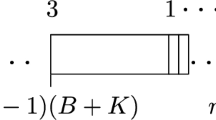Abstract
We investigate the problem of keeping the maximum number of starting times of a baseline schedule if some machines happen to be out of order when the baseline schedule is to be implemented. If the machines are identical, we show that the problem is polynomially solved when no deadline is imposed on the reactive schedule and is strongly NP-hard otherwise. If the number of unrelated machines is fixed and if no deadline is imposed on the reactive schedule, a polynomial algorithm, based on a state graph, has been developed. We conclude with an open complexity question and some further research directions for this class of problems.









Similar content being viewed by others
Notes
French electricity supplier.
Sorbonne Université, Campus Pierre et Marie Curie, Paris.
References
Barták, R., Veira, G. E., Herrmann, J., & Lin, E. (2003). Rescheduling manufacturing systems: A framework of strategies, policies and methods. Journal of Scheduling, 6, 39–62.
Bendotti, P., Chrétienne, P., Fouilhoux, P., & Quilliot, A. (2017). Anchored reactive and proactive solutions to the CPM scheduling problem. European Journal of Operational Research, 261(1), 67–74.
Chrétienne, P. (2018). Reactive and proactive single-machine scheduling to maintain a maximum number of starting times. Annals of Operations Research. https://doi.org/10.1007/s10479-018-2763-9.
Fulkerson, D. R., & Gross, O. A. (1965). Incidence matrices and interval graphs. Pacific Journal of Mathematics, 15, 835–855.
Garey, M., & Johnson, D. S. (1979). Computers and intractability: A guide to the theory of NP-completeness. New York: W.H. Freeman and Company.
Hazir, O., Haouari, M., & Erel, E. (2010). Robust scheduling and robustness measures for the discrete time/cost trade-off problem. European Journal of Operational Research, 207(2), 633–643.
Herroelen, W., & Leus, R. (2004a). The construction of stable project baseline schedules. European Journal of Operational Research, 156(3), 550–565.
Herroelen, W., & Leus, R. (2004b). Robust and reactive project scheduling: a review and classification of procedures. International Journal of Production Research, 42(8), 1599–1620.
Vieira, G. E., Müller, T., & Rudovà, H. (2003). Minimal perturbation problem: A formal view. Neural Network World, 13(5), 501–511.
Author information
Authors and Affiliations
Corresponding author
Additional information
Publisher's Note
Springer Nature remains neutral with regard to jurisdictional claims in published maps and institutional affiliations.
Correctness proof of ALG(X, m, f)
Correctness proof of ALG(X, m, f)
Proof
We denote by L the list \((1,\ldots ,n)\).
Let H be the subset returned by ALG(X, m, f), and let \(H^*\) be an optimal x-compatible subset. Let i be the first job of L that belongs to H but not to \(H^*\). From the definition of i, every job \(k\in \{1,\ldots ,i-1\}\) either belongs to H and \(H^*\), or does not belong either to H or \(H^*\). So \(H^*\) contains a job \(j>i\) that does not belong to H since otherwise the number of jobs of \(S^*\) would be less than the number of jobs of H. Let us consider such a job j (\(j\in H^*\), \(j\not \in H\)) with a minimum \(x_j\) (see Fig. 10) and consider the set \(\bar{H}=H^*\setminus \{j\}\cup \{i\}\).
From the definition of j, every job \(k>i\) such that \(x_k<x_j\) satisfies either (\(k\not \in H^*\), \(k\not \in H\)) or (\(k\in H^*\), \(k\in H\)) or (\(k\not \in H^*\), \(k\in H\)). Since \(x_j+p_j\ge x_i+p_i\), after time \(x_j\), the number of active jobs in \({\bar{H}}\) is at most equal to the number of active jobs in \(H^*\). Before time \(x_j\), the active jobs of \({\bar{H}}\) are also the active jobs of H. So, \({\bar{H}}\) is also an optimal solution. Further, we can repeat that exchange process until there is no such job i and conclude that H is an optimal x-compatible subset. \(\square \)
Rights and permissions
About this article
Cite this article
Chrétienne, P. Maximizing the number of jobs scheduled at their baseline starting times in case of machine failures. J Sched 23, 135–143 (2020). https://doi.org/10.1007/s10951-019-00621-x
Published:
Issue Date:
DOI: https://doi.org/10.1007/s10951-019-00621-x





